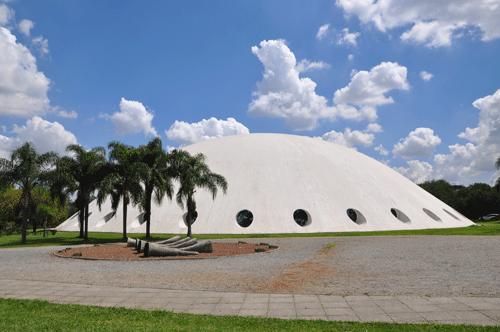Social Awareness: Golden Lions at the Architecture Biennale 2012

A high-rise squat in Caracas and a collection of emergency housing in a tsunami-devastated region in Japan: these are the Golden Lion winners at the Venice Biennale 2012.
Urban Think Tank (Alfredo Brillembourg and Hubert Klumpner), Justin McGuirk and Iwan Baan, were awarded the Golden Lion for Best Project of the Common Ground Exhibition for their work on a high-rise building in Caracas occupied by homeless people – many families – and bearing the symbolic name Torre David. They brought a part of the project to Venice in the form of a temporary café set up in the middle of the Arsenale. The Golden Lion for Best National Participation went to the Japanese Pavilion, in which the curator Toyo Ito exhibited a reconstruction project for the Rikuzentakata area that was severely affected by the tsunami. The jury clearly honoured contributions in which architecture is practised as a social culture. The other Lions were awarded to a cross-section of various other interpretations of the Common Ground theme of this Biennale.
The café in the Arsenale and the Torre David in Caracas (Photographs: Iwan Baan)
The Torre David is an unfinished and abandoned building in Caracas that was originally planned as a bank building in the 90s. Within the last five years, the never finished 45-storey Torre Confinanzas has been adopted as a home by about three thousand people. The tower isn't a slum, but a well-organised community that looks after itself with the help of the Protestant Church: there are shops, little restaurants and apartments initially furnished with cardboard are made more homely successively. Urban Think Tank studied this vertical city and brought a 'piece' of it to Venice: a lively café right in the middle of the Arsenale, with TVs in the corners and photographs of the Torre on rough brick walls, a place to meet, eat, drink and talk. The jury honoured the contribution as "as an inspirational model acknowledging the strength of informal societies".
An exhibition entitled Architecture possible here? – Home for All is on show in the Japanese Pavilion. In this project, Toyo Ito collaborated with the architects Kumiko Inui, Sou Fujimoto and Skihisa Hirata, as well as with the local community of Rikuzentakata, who lost their houses after the tsunami in March 2011. The large-size photographs of the area taken before and immediately after the catastrophe, as well as during the re-building process, enter a dialogue with the innumerable small models of houses developed within the Home for All reconstruction programme.
A Silver Lion for a Promising Practice was awarded to Grafton Architects (a team of two Irish ladies, Yvonne Farrell and Shelley McNamara). The jury was impressed by their presentation of the winning design in a competition held for a University campus in Lima, connecting to the work of Paulo Mendes da Rocha and the relationships between landscape and architecture in diverse studies. The most important reference for them was the football stadium by Mendes da Rocha in Goiâna, Brazil, acting as a source of inspiration for the idea of a university as an "arena of learning".
The jury also awarded four Special Mentions: the Polish Pavilion (designed by Katarzyna Krakowiak, curator Michal Libera) received one for the installation Making the walls quake as if they were dilating with the secret knowledge of great powers. The senses are challenged in the Polish Pavilion during this Biennale: the floor and walls are tilted at slight angles, an irritating buzzing and vibrating emanates from the walls, the space is immersed in warm white light – nothing is as it seems. "This brave and bold installation reminds the visitor to listen as well as to look... And to feel the sound of the Common Ground.", the jury stated.
Cino Zucchi also got a Special Mention for his contribution Copycat, in which he used a variety of different collections to create an own cosmos of similarities: everyday objects like chapati rolling pins next to pictures of building façades (Giovanna Silva), tiny warships, miniature souvenirs, insects, working models or Dress Code Studies by the artist duo Ari Versluis and Ellie Uyttenbroek. "An exemplary reminder of the all-embracing theme of the Common Ground Exhibition," according to the jury.
The Russian Pavilion (curated by Sergei Tchoban) was also awarded a Special Mention: 'i-city/i-land' is the name of a breath-taking installation split in two parts in the upper and lower levels of the pavilion. The lower level presents the history of anonymous or hidden science cities under the Soviet regime, while the upper QR code dome is dedicated to a Russian celebration of digital technology and the new research city Skolkovo Innovation Center. The jury "was drawn into this magical mystery tour and beguiled by its visual presentation".
The US American contribution Spontaneous Interventions: Design Actions for the Common Good was also awarded a Special Mention – yet another social or participatory project: the "interactive installation" impressed the jury "with its celebration of the power of individuals to change society in small but effective ways" and received special praise for the "unpretentiously simple presentation" – project documentations can be studied by pulling down corresponding blinds.
Last but not least: as already announced earlier, Álvaro Siza Viera was awarded the Golden Lion for Lifetime Achievement. He could however not accept the award personally at the Biennale for health reasons.

